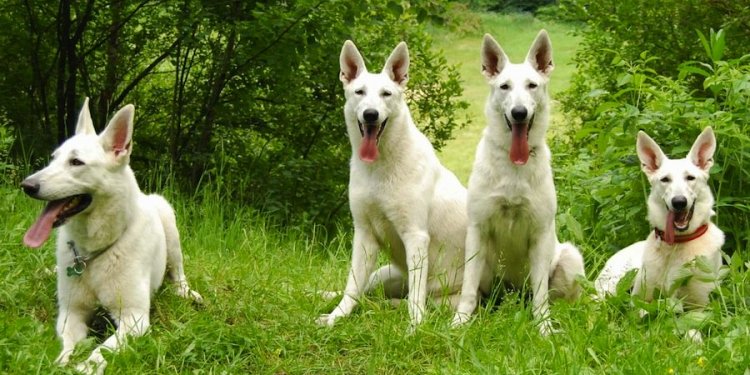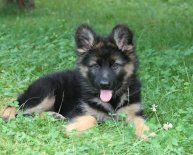
White German Shepherd Dog
 In German Shepherd Dogs the recessive gene for white coat hair was cast in the breed gene pool by the late 19th and early 20th century breeding program that developed and expanded the German Shepherd Dog breed in Germany. A white herding dog named Greif was the grandfather of Horand von Grafrath, the dog acknowledged as the foundation of all contemporary German Shepherd Dog bloodlines. Rittmeister Max von Stephanitz December 1864 to April 1936 Information provided in early books on the German Shepherd Dog make mention of Greif and other white German herding dogs, with upright ears and a general body description that resembles modern German Shepherd Dogs, shown in Europe as early as 1882. The early 20th century German Shepherd breeding program extensively line bred and inbred "color coat" dogs that carried Greif's recessive gene for "white coats" to refine and expand the population of early German Shepherd Dogs. White coats were made a disqualification in the German Shepherd Dog Club of Germany breed standard in 1933 after the breed club came under the control of the German Nazi party that took over all aspects of German society in February 1933 when Hitler declared a state of emergency. The German breed standard remained unchanged as German breeders repopulated the breed in the years after the conclusion of WWII.
In German Shepherd Dogs the recessive gene for white coat hair was cast in the breed gene pool by the late 19th and early 20th century breeding program that developed and expanded the German Shepherd Dog breed in Germany. A white herding dog named Greif was the grandfather of Horand von Grafrath, the dog acknowledged as the foundation of all contemporary German Shepherd Dog bloodlines. Rittmeister Max von Stephanitz December 1864 to April 1936 Information provided in early books on the German Shepherd Dog make mention of Greif and other white German herding dogs, with upright ears and a general body description that resembles modern German Shepherd Dogs, shown in Europe as early as 1882. The early 20th century German Shepherd breeding program extensively line bred and inbred "color coat" dogs that carried Greif's recessive gene for "white coats" to refine and expand the population of early German Shepherd Dogs. White coats were made a disqualification in the German Shepherd Dog Club of Germany breed standard in 1933 after the breed club came under the control of the German Nazi party that took over all aspects of German society in February 1933 when Hitler declared a state of emergency. The German breed standard remained unchanged as German breeders repopulated the breed in the years after the conclusion of WWII. In 1959 the German Shepherd Dog Club of America (GSDCA) adopted the exclusively colored breed standard of the parent German breed club. White-coated German Shepherd Dogs were officially barred from competition in the American Kennel Club conformation ring in the United States starting in 1968. AKC-registered white German Shepherd Dogs may still compete in performance events. During the 1970s, white dog fanciers in the United States and Canada formed their own "White German Shepherd" breed clubs, breeding and showing their dogs at small specialty dog shows throughout North America.
In 1959 the German Shepherd Dog Club of America (GSDCA) adopted the exclusively colored breed standard of the parent German breed club. White-coated German Shepherd Dogs were officially barred from competition in the American Kennel Club conformation ring in the United States starting in 1968. AKC-registered white German Shepherd Dogs may still compete in performance events. During the 1970s, white dog fanciers in the United States and Canada formed their own "White German Shepherd" breed clubs, breeding and showing their dogs at small specialty dog shows throughout North America.
Albino is a "trait" all its own. It occurs in most all mammals, including
Humans and even deer. Just below is a very good example
of the ALBINO trait in deer. Notice the absolute absence of
"color pigment" of this animal. Eyes, nose, even hoofs are without
Color Pigment. All animals that are genetic colors of their species and breeds
have certain color characteristics. These Characteristics do NOT include
Albino. Albino is a genetic defect that leaves the animal "without" the
normal color pigmentation present in the remainder of the species.
"ALBINO" is NOT a color. ALBINO should not even be considered as
it is the result of an absence of chromosomes that provide color.
White animals have chromosomes that do provide the white color much the













